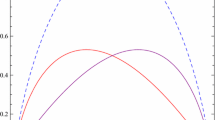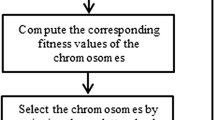Abstract
Fuzzy statistics have been developing for decades and though many contributions have gone into the expansion of theorems, most practitioners in the field of finance who usually use statistical methods actually seldom apply fuzzy set theory. One of the more likely reasons is that many operation rules of fuzzy statistics are still in progress. Among them, the statistical measures of mean, variance, and standard deviation of fuzzy numbers are the most practically used in descriptive and inferential statistics. Although they have been investigated before, previous studies on fuzzy variance and standard deviation are either defective or too rough to follow. This work therefore step-by-step develops their definitions, computational algorithms, propositions, and proofs. The deficiency of fuzzy variance is mended by substituting the requisite equality-constraint operation for standard fuzzy arithmetic. The derivation of membership functions completely depicts the shapes of the fuzzy measures and is not just an approximation. Finally a numerical example of portfolio selection illustrates the calculation process and their use.
Similar content being viewed by others
References
Bortolan G, Degani R (1985) A review of some methods for ranking fuzzy subsets. Fuzzy Sets Syst 15:1–19. doi:10.1016/0165-0114(85)90012-0
Buckley JJ (1987) The fuzzy mathematics of finance. Fuzzy Sets Syst 21:257–273. doi:10.1016/0165-0114(87)90128-X
Carlsson C, Fuller R (2001) On possibilistic mean value and variance of fuzzy numbers. Fuzzy Sets Syst 122:315–326. doi:10.1016/S0165-0114(00)00043-9
Chen SJ, Hwang CL (1992) Fuzzy multiple attribute decision making. Springer, Berlin
Chiang D-A, Lin NP (1999) Correlation of fuzzy sets. Fuzzy Sets Syst 102:221–226. doi:10.1016/S0165-0114(97)00127-9
Chu TC, Lin Y (2009) An extension to fuzzy MCDM. Computers and mathematics with applications 57:445–454. doi:10.1016/j.camwa.2008.10.076
Dubois D, Prade H (1978) Operations on fuzzy numbers. Int J Syst Sci 9(6):613–626. doi:10.1080/00207727808941724
Dubois D, Prade H (1986) Fuzzy sets and statistical data. Eur J Oper Res 25:345–356. doi:10.1016/0377-2217(86)90266-3
Feng Y, Hu L, Shu H (2001) The variance and covariance of fuzzy random variables and their applications. Fuzzy Sets Syst 120:487–497. doi:10.1016/S0165-0114(99)00060-3
Fruhwirth-Schnatter S (1992) On statistical inference for fuzzy data with applications to descriptive statistics. Fuzzy Sets Syst 50:143–165. doi:10.1016/0165-0114(92)90213-N
Fuller R, Majlender P (2003) On weighted possibilistic mean and variance of fuzzy numbers. Fuzzy Sets Syst 136:363–374. doi:10.1016/S0165-0114(02)00216-6
Hong DH (2006) Fuzzy measures for a correlation coefficient of fuzzy numbers under Tw (the weakest t-norm)-based fuzzy arithmetic operations. Inf Sci 176:150–160. doi:10.1016/j.ins.2004.11.005
Hryniewicz O (2006) Possibilistic decisions and fuzzy statistical tests. Fuzzy Sets Syst 157:2665–2673. doi:10.1016/j.fss.2003.08.009
Kaufmann A, Gupta MM (1988) Fuzzy mathematical models in engineering and management science. North-Holland, Amsterdam
Kaufmann A, Gupta MM (1991) Introduction to fuzzy arithmetic: theory and application. VanNostrand Reinhold, New York
Klir GJ (1997) Fuzzy arithmetic with requisite constraints. Fuzzy Sets Syst 91:165–175. doi:10.1016/S0165-0114(97)00138-3
Kwakernaak H (1978) Fuzzy random variables—I, II definitions and theorems. J Inf Sci 15:1–29
Kwakernaak H (1979) Fuzzy random variables—I, II definitions and theorems. J Inf Sci 17:153–178
Lee HT (2001) C PK index estimation using fuzzy numbers. Eur J Oper Res 129:683–688. doi:10.1016/S0377-2217(99)00438-5
Leekwijck WV, Kerre EE (1999) Defuzzification: criteria and classification. Fuzzy Sets Syst 108:159–178. doi:10.1016/S0165-0114(97)00337-0
Liu ST, Kao C (2002) Fuzzy measures for correlation coefficient of fuzzy numbers. Fuzzy Sets Syst 128:267–275. doi:10.1016/S0165-0114(01)00199-3
Markowitz HM (1952) Portfolio selection. J Finance 77–91. doi:10.2307/2975974
Puri ML, Ralescu DA (1986) Fuzzy random variables. J Math Anal Appl 114:409–422. doi:10.1016/0022-247X(86)90093-4
Wang X, Kerre EE (2001a) Reasonable properties for the ordering of fuzzy quantities (I). Fuzzy Sets Syst 118(3):375–385. doi:10.1016/S0165-0114(99)00062-7
Wang X, Kerre EE (2001b) Reasonable properties for the ordering of fuzzy quantities (II). Fuzzy Sets Syst 118(3):387–405. doi:10.1016/S0165-0114(99)00063-9
Wu HC (2003) The fuzzy estimators of fuzzy parameters based on fuzzy random variables. Eur J Oper Res 146:101–114. doi:10.1016/S0377-2217(02)00140-6
Zadah LA (1965) Probability measures of fuzzy events. J Math Anal Appl 23:421–427. doi:10.1016/0022-247X(68)90078-4
Zadeh LA (1968) Fuzzy sets. Inf Contr 8:338–353. doi:10.1016/S0019-9958(65)90241-X
Acknowledgments
The author would like to thank Prof. Dr. Brunella Gerla and the anonymous referees for providing valuable comments and suggestions. This work was supported by National Science Council, Taiwan, ROC under Grant NSC96-2416-H-251-010-MY2.
Author information
Authors and Affiliations
Corresponding author
Appendix
Appendix
The Appendix presents the proofs of Propositions 1–3.
Proof of Proposition 1
From Definition 1, \( A_{L} ,\;B_{L} ,\;A_{U} , \) and \( B_{U} \) are constant numbers. In Eq. 12 both \( f_{{\tilde{\mu }_{{\tilde{X}}} }}^{L} (r) \) and \( f_{{\tilde{\mu }_{{\tilde{X}}} }}^{R} (r) \) are linear functions of r. Because \( \tilde{\mu }_{{\tilde{X}}} \) has linear left and right membership functions, it is a triangular fuzzy number. □
Proof of Proposition 2
-
(1)
\( \because \;{}^{\alpha }\overline{{D_{{\tilde{x}_{j} }} }}^{2} ,\;{}^{\alpha }\underline{{D_{{\tilde{x}_{j} }} }}^{2} , \) 0, and \( \max \left( {{}^{\alpha }\underline{{D_{{\tilde{x}_{j} }} }}^{2} ,{}^{\alpha }\overline{{D_{{\tilde{x}_{j} }} }}^{2} } \right) \) are zero or positive, (see Eq. 13)
\( \therefore \;{}^{\alpha }\underline{{\sigma_{{\tilde{X}}}^{2} }} \) and \( {}^{\alpha }\overline{{\sigma_{{\tilde{X}}}^{2} }} \) are non-negative. (Eq. 14)
-
(2)
If \( \tilde{\sigma }_{{\tilde{X}}}^{2} \) is a fuzzy number, then it is to prove: \( {}^{0}\underline{{\sigma_{{\tilde{X}}}^{2} }} \le {}^{1}\underline{{\sigma_{{\tilde{X}}}^{2} }} \le {}^{1}\overline{{\sigma_{{\tilde{X}}}^{2} }} \le {}^{0}\overline{{\sigma_{{\tilde{X}}}^{2} }} . \)
\( \therefore \) This is to prove: \( I_{L} \le G_{L} + H_{L} + I_{L} \le G_{U} + H_{U} + I_{U} \le I_{U} . \)
\( \therefore \) This is to prove that:
-
1.
\( (c_{j} - \mu_{a} )^{2} \le (b_{j} - \mu_{b} )^{2} \le (b_{j} - \mu_{b} )^{2} \le (a_{j} - \mu_{c} )^{2}, \) when \( {}^{\alpha }\overline{{D_{{\tilde{x}_{j} }} }} < 0; \)
-
2.
\( (a_{j} - \mu_{c} )^{2} \le (b_{j} - \mu_{b} )^{2} \le (b_{j} - \mu_{b} )^{2} \le (c_{j} - \mu_{a} )^{2}, \) when \( {}^{\alpha }\underline{{D_{{\tilde{X}_{j} }} }} > 0; \)
-
3.
\( 0 \le 0 \le (b_{j} - \mu_{b} )^{2} \le (c_{j} - \mu_{a} )^{2}, \) when \( 0 \in \left[ {{}^{\alpha }\underline{{D_{{\tilde{X}_{{_{j} }} }} }} ,{}^{\alpha }\overline{{D_{{\tilde{X}_{j} }} }} } \right],\left| {{}^{\alpha }\underline{{D_{{\tilde{X}_{j} }} }} } \right| \le \left| {{}^{\alpha }\overline{{D_{{\tilde{X}_{j} }} }} } \right|; \)
-
4.
\( 0 \le 0 \le (b_{j} - \mu_{b} )^{2} \le (a_{j} - \mu_{c} )^{2}, \) when \( 0 \in \left[ {{}^{\alpha }\underline{{D_{{\tilde{x}_{j} }} }} ,{}^{\alpha }\overline{{D_{{\tilde{x}_{j} }} }} } \right],\left| {{}^{\alpha }\underline{{D_{{\tilde{x}_{j} }} }} } \right| \ge \left| {{}^{\alpha }\overline{{D_{{\tilde{x}_{j} }} }} } \right|. \)
Refer to Eq. 13 \( \Rightarrow \;{}^{0}\underline{{D_{{\tilde{x}_{j} }} }} = a_{j} - \mu_{c} \le {}^{1}\underline{{D_{{\tilde{x}_{j} }} }} = b_{j} - \mu_{b} \le {}^{1}\overline{{D_{{\tilde{x}_{j} }} }} = b_{j} - \mu_{b} \le {}^{0}\overline{{D_{{\tilde{x}_{j} }} }} = c_{j} - \mu_{a} \)
If \( {}^{\alpha }\overline{{D_{{\tilde{x}_{j} }} }} < 0 \Rightarrow 0 < {}^{0}\overline{{D_{{\tilde{x}_{j} }} }}^{2} \le {}^{1}\overline{{D_{{\tilde{x}_{j} }} }}^{2} \le {}^{1}\underline{{D_{{\tilde{x}_{j} }} }}^{2} \le {}^{0}\underline{{D_{{\tilde{x}_{j} }} }}^{2} \)
\( \Rightarrow \;0 < (c_{j} - \mu_{a} )^{2} \le (b_{j} - \mu_{b} )^{2} \le (b_{j} - \mu_{b} )^{2} \le (a_{j} - \mu_{c} )^{2} \) {1. is proven}.
If \( {}^{\alpha }\underline{{D_{{\tilde{X}_{j} }} }} > 0 \Rightarrow 0 < {}^{0}\underline{{D_{{\tilde{x}_{j} }} }}^{2} \le {}^{1}\underline{{D_{{\tilde{x}_{j} }} }}^{2} \le {}^{1}\overline{{D_{{\tilde{x}_{j} }} }}^{2} \le {}^{0}\overline{{D_{{\tilde{x}_{j} }} }}^{2} \)
\( \Rightarrow \;0 < (a_{j} - \mu_{c} )^{2} \le (b_{j} - \mu_{b} )^{2} \le (b_{j} - \mu_{b} )^{2} \le (c_{j} - \mu_{a} )^{2} \) {2. is proven}.
If \( 0 \in \left[ {{}^{\alpha }\underline{{D_{{\tilde{X}_{j} }} }} ,{}^{\alpha }\overline{{D_{{\tilde{X}_{j} }} }} } \right],\left| {{}^{\alpha }\underline{{D_{{\tilde{X}_{j} }} }} } \right| \le \left| {{}^{\alpha }\overline{{D_{{\tilde{X}_{j} }} }} } \right| \Rightarrow {}^{\alpha }\tilde{D}_{{\tilde{x}_{j} }}^{2} = \left[ {0,\max \left( {{}^{\alpha }\underline{{D_{{\tilde{x}_{j} }} }}^{2} ,{}^{\alpha }\overline{{D_{{\tilde{x}_{j} }} }}^{2} } \right)} \right] = \left[ {0,{}^{\alpha }\overline{{D_{{\tilde{x}_{j} }} }}^{2} } \right] \)
\( \Rightarrow 0 \le {}^{1}\overline{{D_{{\tilde{x}_{j} }} }}^{2} \le {}^{0}\overline{{D_{{\tilde{x}_{j} }} }}^{2} \Rightarrow 0 \le (b_{j} - \mu_{b} )^{2} \le (c_{j} - \mu_{a} )^{2} \) {3. is proven}.
If \( 0 \in \left[ {{}^{\alpha }\underline{{D_{{\tilde{X}_{j} }} }} ,{}^{\alpha }\overline{{D_{{\tilde{X}_{j} }} }} } \right],\left| {{}^{\alpha }\underline{{D_{{\tilde{X}_{j} }} }} } \right| \ge \left| {{}^{\alpha }\overline{{D_{{\tilde{X}_{j} }} }} } \right| \Rightarrow {}^{\alpha }\tilde{D}_{{\tilde{x}_{j} }}^{2} = \left[ {0,\max \left( {{}^{\alpha }\underline{{D_{{\tilde{x}_{j} }} }}^{2} ,{}^{\alpha }\overline{{D_{{\tilde{x}_{j} }} }}^{2} } \right)} \right] = \left[ {0,{}^{\alpha }\underline{{D_{{\tilde{x}_{j} }} }}^{2} } \right] \)
\( \Rightarrow 0 \le {}^{1}\underline{{D_{{\tilde{x}_{j} }} }}^{2} \le {}^{0}\underline{{D_{{\tilde{x}_{j} }} }}^{2} \Rightarrow 0 \le (b_{j} - \mu_{b} )^{2} \le (a_{j} - \mu_{c} )^{2} \) {4. is proven}.
-
(3)
\( \because \;f_{{\tilde{\sigma }_{{\tilde{X}}}^{2} }} \) are non-linear. (see Eq. 16) \( \therefore \;\tilde{\sigma }_{{\tilde{X}}}^{2} \) is not in a triangular shape. □
Proof of Proposition 3
Since \( {}^{\alpha }\tilde{\sigma }_{{\tilde{X}}} = \sqrt {{}^{\alpha }\tilde{\sigma }_{{\tilde{X}}}^{2} } ,\;{}^{\alpha }\tilde{\sigma }_{{\tilde{X}}} \) complies with the properties of \( {}^{\alpha }\tilde{\sigma }_{{\tilde{X}}}^{2} \) as in Proposition 2. □
Rights and permissions
About this article
Cite this article
Tsao, CT. The revised algorithms of fuzzy variance and an application to portfolio selection. Soft Comput 14, 329–337 (2010). https://doi.org/10.1007/s00500-009-0407-3
Published:
Issue Date:
DOI: https://doi.org/10.1007/s00500-009-0407-3




